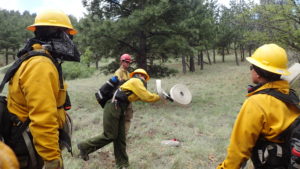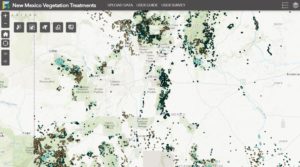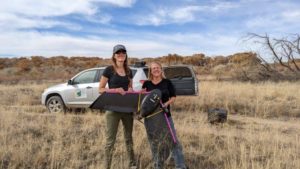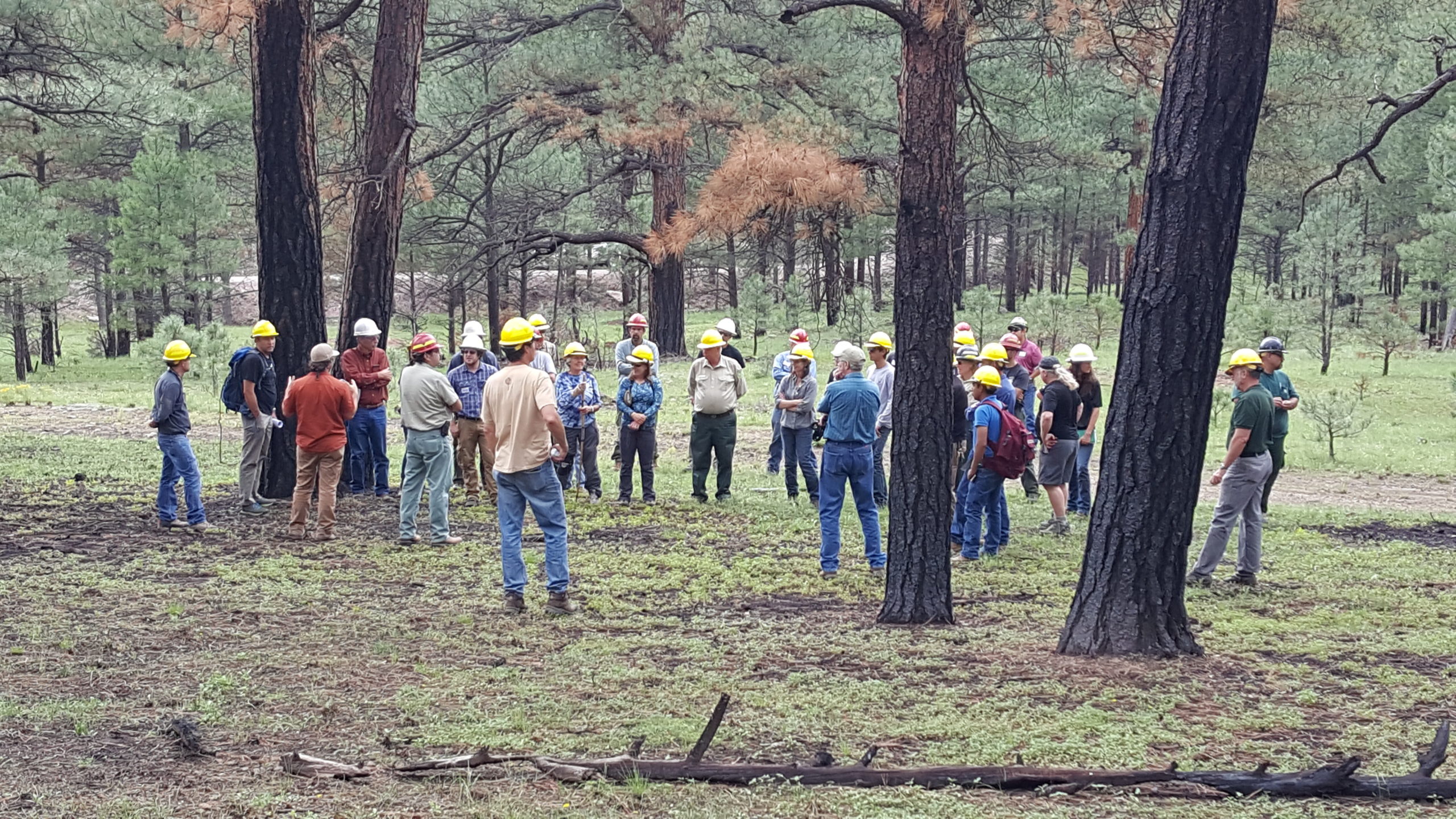
Monitoring crew members from the New Mexico Forest and Watershed Restoration Institute, including Carly Drobnick and Richard Pratt, go through wildland fire fighting exercises as part of their field training.
January 26, 2021
Three institutes working to improve forest health and reduce catastrophic wildfires in the West will get a $20 million financial boost from the Infrastructure Investment and Jobs Act passed by Congress in November.
The funding will help expand a vegetation treatment database nationwide and measure the effectiveness of forest treatments.
The funds will go to the Southwest Ecological Restoration Institutes, or SWERI, made up of The New Mexico Forest and Watershed Restoration Institute at Highlands University, the Ecological Restoration Institute at Northern Arizona University and the Colorado Forest Restoration Institute at Colorado State University. The funding SWERI will receive is a part of the $5.4 billion allocated in the bill for wildfire mitigation and forest restoration, according to Alan Barton, director of the New Mexico Forest and Watershed Restoration Institute (NMFWRI).
Barton said SWERI is the result of legislation passed by Congress in 2004 that charged the three institutes with promoting adaptive management practices. Each institute engages in its own range of monitoring, restoration, and research projects, but Barton says the funding from Congress will enable the three institutes to work together more closely.
“There are five parts to the very large infrastructure act,” said Barton. “But the significant project in there is taking the New Mexico vegetation treatment database and turning it into a national database.”
According to Katie Withnall, the geographic information systems, or GIS, specialist at NMFWRI, the vegetation treatment database was started before she was hired in 2017, but she has since expanded the database to include over 50,000 treatment projects across New Mexico and southern Colorado. She said most treatments involve tree removal, but that the database is categorized by treatment types, which include physical, chemical, fire, and biological methods.

Snapshot of the vegetation treatment database created by the New Mexico Forest and Watershed Restoration Institute
“Most of the treatments are for forest management for the prevention of catastrophic wildfire—a lot of that is thinning and prescribed fires,” said Withnall. “We also have riparian treatments in there—a lot of treatments to remove non-native phreatophytes like saltcedar and Russian-olive, tree removal like chipping and pile burning, and chemical rangeland and noxious weed treatments.”
Withnall said the Bureau of Land Management, or BLM, began mapping treatments as early as the 1940s, but it wasn’t until GIS technology was popularized half a century later that more agencies and organizations began collecting data in earnest.
“We get data primarily from some of the bigger agencies—the Department of Agriculture and Department of Interior, the Forest Service, BLM, and New Mexico State Forestry, which is a big one that works on private land,” said Withnall. “We also get data from the tribes, Soil and Water Conservation Districts, some municipalities, and the State Land Office—basically all of the agencies that do any kind of land management work.”
Withnall said the database provides the information needed for fire modeling, which can help predict wildfire risk, and it helps land managers with cross-boundary planning.
“With a database like this, people can see what’s on the other side of the fence line when they’re planning their own treatments,” said Withnall.
Barton said treatments must be done every 10 to 15 years which is vital to reducing fuel for forest fires.
“Typically, if there are a lot of trees, they’re going to be pretty small and that makes the forest a lot more susceptible to these catastrophic fires,” said Barton. “When they’re closer together, the fire can jump more quickly between the trees and if they’re smaller, they burn more easily.”
According to Barton, ponderosa forests historically burned roughly every decade or two, and burned low to the ground among large, dispersed trees.
“Since we’ve been suppressing wildfires, all those little seedlings just kept growing, and now we just have way too many of them and none of them get very big because they’re competing with each other,” said Barton. “When you have too many trees and so much fuel, there’s so much more to burn and it burns more easily and carries the fire up into the crowns of the trees.”
Once a fire goes into the crowns of the trees, Barton said it gets big fast. Combined with drought conditions and insect and disease attacks—which smaller trees are also more susceptible to due to their size and clustering—catastrophic fires become more prevalent across the West, burning hundreds of thousands of acres each year.
“We’ve created forests that were good for us when we wanted to get a lot of trees and build a lot of houses and have a lot of paper, but in over a century of management, we created forests that were not functioning ecologically anymore the way they had historically,” said Barton. “Now our focus is on trying to restore those historic ecological conditions.”
As federal, state, and private agencies work towards restoring historic ecological conditions by removing small trees and conducting prescribed burns, among other treatments, Barton said mapping these treatments provides the infrastructure that facilitates the work on the ground.
“The question we’re grappling with right now is, how do we take that map and turn it into a nationwide map. That was the charge that Congress gave us,” said Barton. “But not every state looks like New Mexico—some states have much more intensive forest management, and some states have very few forests, and little forest management.”
Barton said SWERI will receive the funding over five years and he anticipates that they’ll begin building the national database by starting in the Southwest and expanding out from there.
“The hardest part of this is just identifying all the treatments and keeping up with all the new treatments,” said Barton. “Part of what we need to do is figure out how much of what we’ve done in New Mexico is going to be relevant to what people need elsewhere, and then find local partners who can keep that going.”

Katie Withnall and Patricia Dappen, GIS specialists with the New Mexico Forest and Watershed Restoration Institute, have mapped more than 50,000 vegetation treatment projects in New Mexico.
Withnall said several other states already have some form of a treatment database, though to her knowledge none are as comprehensive as New Mexico’s.
“There are a couple of national databases, but they are not nearly as complete and don’t have the same scope,” said Withnall. “We do need to see what else is out there though so we’re not reinventing the wheel.”
In addition to creating a national treatment database, Barton said some of the funding will also be used for research to assess the effectiveness of various treatment methods. Although there isn’t much research on treatments, Barton said there is anecdotal evidence that treatments help keep fires on the ground, which prevents them from becoming catastrophic.
“We’ve seen that a fire will be raging in areas that weren’t treated and then it gets to a treated area, and it just drops to the ground,” said Barton. “There was a fire in Ruidoso five years ago—the Moon Mountain fire—that was headed down the mountain right towards the high school, but it hit where the city had done their treatments and just dropped to the ground. When that happens, it gives the firefighting crews a foothold to slow things down.”
Barton said all three institutes also plan to measure the effectiveness of forest treatments.
Barton said creating a national vegetation treatment database and conducting research on treatment effectiveness—among other projects, will require SWERI to expand their staff. Although much of the data collection will happen through partner agencies and organizations, managing, tracking, and maintaining a national database will require the institutes to do some hiring.
“The act is called the Infrastructure Investment and Jobs Act,” said Barton. “So, it will create jobs for New Mexico, hopefully for Las Vegas if we can find some people locally that are interested in working on this, and I think it will create jobs far beyond the SWERIs as well.”
Withnall said the vegetation treatment database is a useful tool and that there’s a real demand for it.
“I have had many people from the state and even from outside of New Mexico email me because they’re using it for modeling or research,” said Withnall. “People from other states remark on how nothing like it really exists in their state. Being able to expand it nationally would just really helpful for policymakers, for land managers, for fire modelers, and for a lot of other people and stakeholders.”
Barton said the Infrastructure Bill has a lot of money in it that will be going through the Forest Service to fund tribes, states, and non-profit organizations who are doing conservation work on the ground. He said increasing forestry jobs and reducing wildfire risk will be a boon to the state.
“Congress is committed to the database, and I think people in forestry see the value of this. It will be a really valuable tool once it’s up and running,” said Barton. “We have an opportunity to make a huge difference in the work that we’re doing.”

